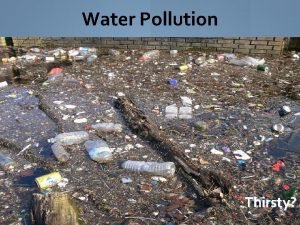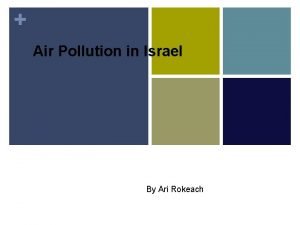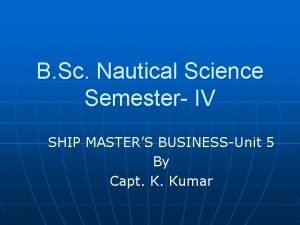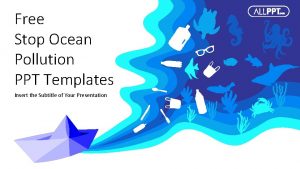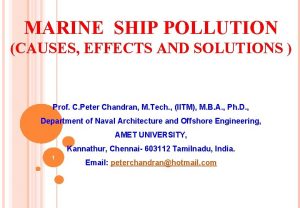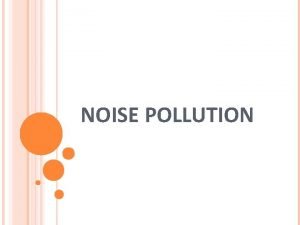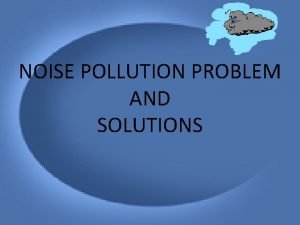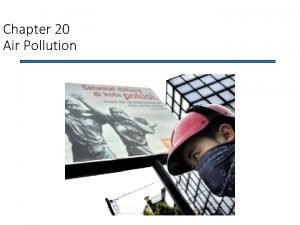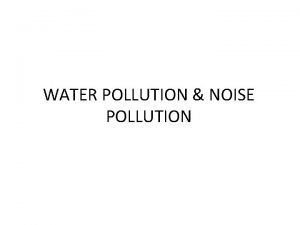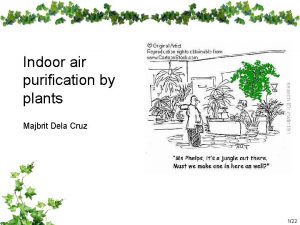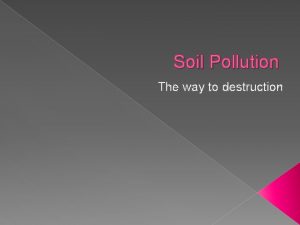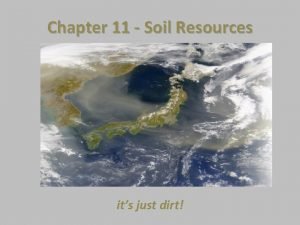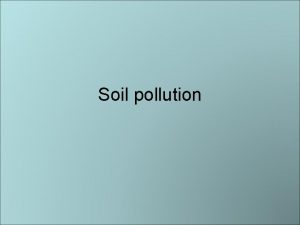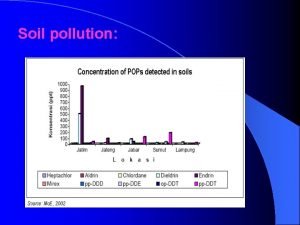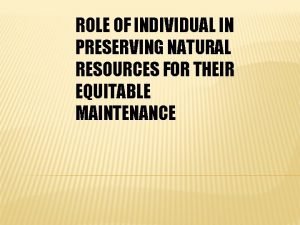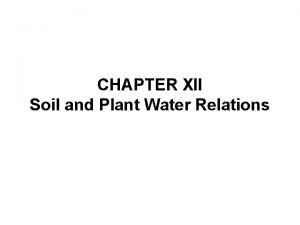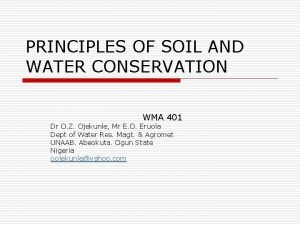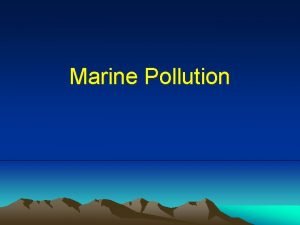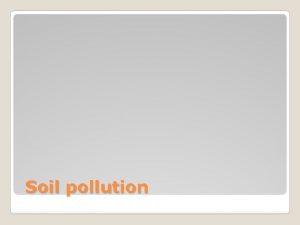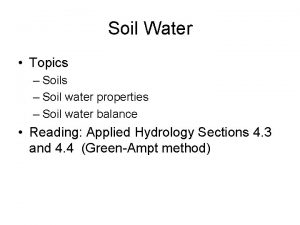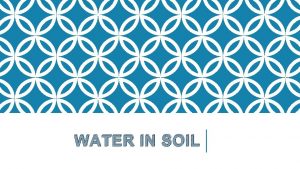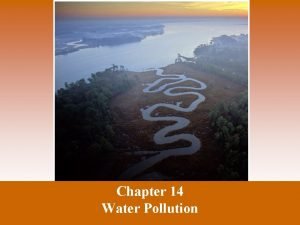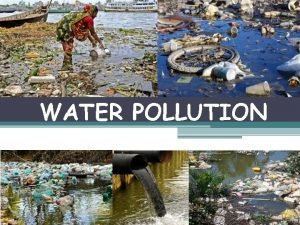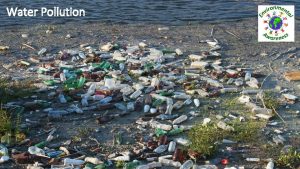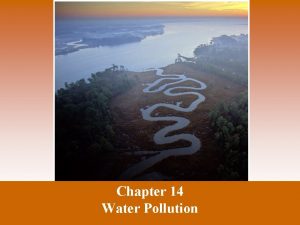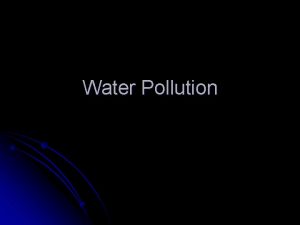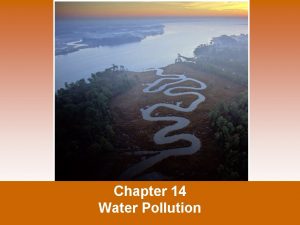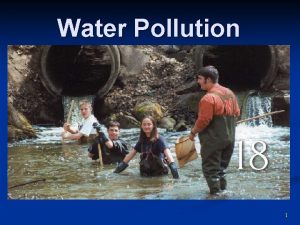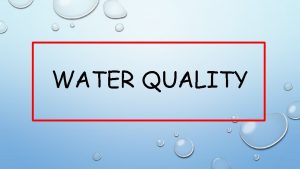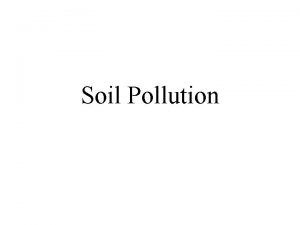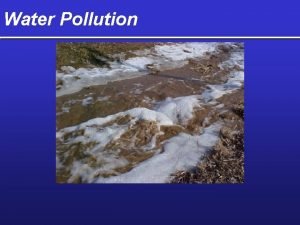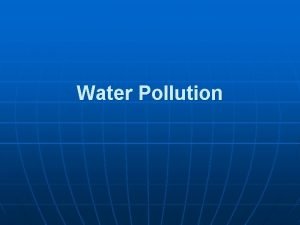WATER SOIL AND MARINE POLLUTION Water pollution Sources



























- Slides: 27

WATER , SOIL, AND MARINE POLLUTION

Water pollution

Sources : - § Point Source § Non Point Source

Types of pollutants § § § § Sediments. Inorganic nutrients. Inorganic chemicals. Infectious micro-organism Organic compounds. Radioactive substances. Thermal pollution. Oxygen demanding organic waste.

Inorganic nutrient control § Nitrogen (in form of nitrates) or phosphorous may be limiting factor in aquatic ecosystem. § Eutrophication = Nutrient enrichment of aquatic ecosystem. --- may be accelerated by human activities.

Arsenic and fluoride problem. § Excessive extraction of groundwater. Effect Indication Solution

How to measure the water quality. § BOD (biological oxygen demanding) § Presence of infectious organism. § Chemical analysis. BOD(ppm) Quality 1 -2 Very good 3 -5 Moderate 6 -9 polluted 10 or more Highly polluted


Methods of purifying water § R. O method. § U. V method. § Distillation method. § Planted filter method.

Treatment of polluted water and sewage.

condition of rivers in India. § § Water of most of the rivers are unfit for drinking. Central Ganga Authority was established in 1985. National River Conservation Directorate (NRCD). More than 500 million has been spent on GAP. Ganga Yamuna

Pesticide in freshwater. § Ag. Sector uses large amount of pesticides. § In 2003, Centre for Science and Environment in Delhi found 34 times more than BIS standards. § Heptachlor, banned in India , was found in 71% of the samples. Source : www. cseindia. org.

sanitation § 2/5 th of the world’s population , mostly in Asia and Africa, lacks sanitation facilities. § 108 millions of rural households and 14 million urban households have no sanitation facilities in India. § Some environmentalists consider the flush toilet as worst invention. A family of five would need more than 150 thousand litres of water to transport 250 liters of excreta every year.

Ecological sanitation § Ecological Sanitation (Eco. San ) is a sustainable closed loop system. § Paul calvert set up Eco. San in numerous homes in kerela. § It regards human excreta as a resource to be recycled than as a waste to be disposed of. § It doesn’t use water to carry away solid waste.

MARINE POLLUTION § Forms 71% of Earth’s surface

CAUSES 1. 2. 3. Industrial discharge Agricultural runoff Treated and untreated human & other domestic wastes. 4. Sewage. 5. Oil industry- leaks, spills, and the cleaning of tankers.

EFFECTS-ALGAL BLOOM § § § Increase in algal population. Produce toxins. Attack nervous system of fishes. Enter into the food web. Kills marine mammals and also human beings. § Affects crabs, oysters and clams.

INTIATIVES SO FAR TO CONTROL § § § London dumping convention. (1972 & 1996) Basel convention. (1989) Convention on prevention of pollution from ships. (MARPOL) § Global programme of action for the protection of the Marine Environment from land based activities. (GPA-LBA) § United Nations Environment Programme. (UNEP)


WHAT IS SOIL POLLUTION? Soil pollution refers to any physical or chemical alteration in the composition of the soil.

Causes of Soil Pollution • • Soil Erosion Sewage Chemical Fertilizers and pesticides Acid rain • • Over Burden of Mines Salts Dumping Toxics


How can the soil condition be restored? • • • Bio-remediation Proper Drainage Afforestation Proper Industrial and Domestic Dumping Using Bio-degradable Products Biological Control


• Take urgent steps to prevent all these form of pollution.

REFERENCES: § § § Environmental Studies : R. Rajagopalan. www. cseindia. org. www. eco-solutions. org. www. downtoearth. org. in. http: //www. cbu. edu/~seisen/Water. Pollution/ sld 001. htm. § Images from Google image

Thank you § § Manish (20) Sambit (41) Shruti (48) Vivek (60)
 Important water resources
Important water resources Major sources of water pollution
Major sources of water pollution Water and water and water water
Water and water and water water Print sources of information
Print sources of information Ari rokeach
Ari rokeach Living soil vs dead soil
Living soil vs dead soil Four major spheres of the earth
Four major spheres of the earth Double hull
Double hull Marine pollution ppt template
Marine pollution ppt template Marine noise pollution
Marine noise pollution Groundwater pollution
Groundwater pollution Sound pollution solutions
Sound pollution solutions Noise pollution problems
Noise pollution problems Sources of smog
Sources of smog Example of noise pollution
Example of noise pollution Mobile sources definition
Mobile sources definition Indoor air pollution sources
Indoor air pollution sources Sources of thermal pollution
Sources of thermal pollution Concept of soil pollution
Concept of soil pollution Soil pollution
Soil pollution Soil pollution project
Soil pollution project 2 causes of soil pollution
2 causes of soil pollution Consequences of soil pollution
Consequences of soil pollution Land water and air pollution
Land water and air pollution Soil pollution
Soil pollution Effects of environmental pollution
Effects of environmental pollution Soil and water relationship
Soil and water relationship Water conservation objectives
Water conservation objectives

